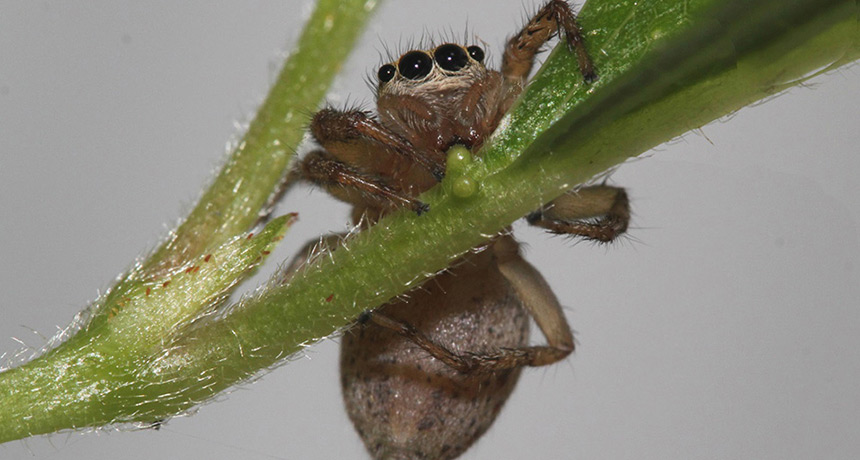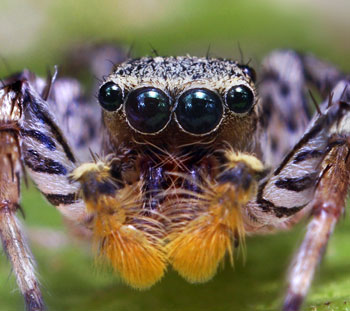Spiders eat insects — and sometimes veggies
Dozens of species of spiders have been reported eating plants

A female Maevia inclemens jumping spider drinks nectar from a shrub.
DAVID E. HILL/PECKHAM SOCIETY, SIMPSONVILLE, S.C.
Spiders eat insects. That’s why some of us are reluctant to kill the spiders we find in our homes. We figure they’ll eat the critters we really don’t want around. But a new study reveals that a spider’s diet can be far more diverse than what many of us learned in school. Many spiders, for instance, have a taste for plants.
Martin Nyffeler studies spiders at the University of Basel in Switzerland. He had seen scattered reports of plant-eating spiders in science journals for years. “I always found this topic very intriguing,” he says, “since I am a vegetarian myself.”
He and his colleagues have now combed books and journals for reports of spiders consuming plant material. There is only one species of spider known to be completely vegan: Bagheera kiplingi. This species of jumping spider lives in Mexico. It survives mostly on bits of acacia (Ah-KAY-shah) trees.

Nyffeler’s group reports on spiders’ taste for greens in the April Journal of Arachnology.
Juicing it
Perhaps past scientists can be forgiven for overlooking this plant-eating behavior. That’s because spiders can’t eat solid food. They have a reputation for sucking the juices out of their prey. But that’s not quite the right description for what happens. A spider actually covers its prey with digestive juices. It then chews the meat with its chelicerae and sucks the juices in.
This eating style means that spiders can’t just cut a piece of leaf or fruit and chow down.
Some spiders feed on leaves by digesting them with enzymes prior to eating, much as they do with meat. Others pierce a leaf with their chelicerae, then suck out plant sap. Still others, such as Bagheera kiplingi, drink nectar from special tissues. Called nectaries, these tissues are found in flowers and other plant structures.
More than 30 species of jumping spiders are nectar feeders, the researchers found. Some spiders have been seen pushing their mouthparts deep into flowers to reach that nectar. This is similar to how some insects drink nectar.
And nectar slurping isn’t accidental behavior by those spiders. Some can feed on 60 to 80 flowers in an hour. “Spiders probably act sometimes unintentionally as pollinators,” Nyffeler says.
Pollen is probably another common plant-based food for spiders, especially those that make outdoor webs. That’s because spiders eat their old webs to recycle the proteins. And when they down those webs, they also eat anything that might be caught on the sticky strands, such as calorie-rich pollen. Spiders also might be consuming tiny seeds and fungal spores this way. Those spores, though, may be a risky meal. That’s because there are many fungi whose spores can kill spiders.
The researchers also found some cases of spiders intentionally eating pollen and seeds. And, they note, many spiders are eating plant material when they munch on plant-eating insects. But most spiders need at least a little meat to get all the nutrients they need.
“The ability of spiders to derive nutrients from plant materials is broadening the food base of these animals,” Nyffeler says. “This might be one of several survival mechanisms helping spiders to stay alive for a while during periods when insect prey is scarce.”
Power Words
(for more about Power Words, click here)
acacia A tree or shrub with white or yellow flowers that grows in warm climates. It often has thorns.
Antarctica A continent mostly covered in ice, which sits in the southernmost part of the world.
arthropod Any of numerous invertebrate animals of the phylum Arthropoda, including the insects, crustaceans, arachnids and myriapods, that are characterized by an exoskeleton made of a hard material called chitin and a segmented body to which jointed appendages are attached in pairs.
chelicerae The name given to the mouthparts found on certain arthropods, such as spiders and horseshoe crabs.
continent (in geology) The huge land masses that sit upon tectonic plates. In modern times, there are six geologic continents: North America, South America, Eurasia, Africa, Australia and Antarctica.
enzymes Molecules made by living things to speed up chemical reactions.
family A taxonomic group consisting of at least one genus of organisms.
fungus (adj. fungal) One of a group of single- or multiple-celled organisms that reproduce via spores and feed on living or decaying organic matter. Examples include mold, yeasts and mushrooms.
insect A type of arthropod that as an adult will have six segmented legs and three body parts: a head, thorax and abdomen. There are hundreds of thousands of insects, which include bees, beetles, flies and moths.
insectivore A creature that eats insects.
nectar A sugary fluid secreted by plants, especially within flowers. It encourages pollination by insects and other animals. It is collected by bees to make into honey.
nectary The part of a plant or its flower that secretes sugary fluid called nectar.
nutrient A vitamin, mineral, fat, carbohydrate or protein that a plant, animal or other organism requires as part of its food in order to survive.
pollen Powdery grains released by the male parts of flowers that can fertilize the female tissue in other flowers. Pollinating insects, such as bees, often pick up pollen that will later be eaten.
pollinator Something that carries pollen, a plant’s male reproductive cells, to the female parts of a flower, allowing fertilization. Many pollinators are insects such as bees.
prey (n.) Animal species eaten by others. (v.) To attack and eat another species.
proteins Compounds made from one or more long chains of amino acids. Proteins are an essential part of all living organisms. They form the basis of living cells, muscle and tissues; they also do the work inside of cells. The hemoglobin in blood and the antibodies that attempt to fight infections are among the better-known, stand-alone proteins.Medicines frequently work by latching onto proteins.
species A group of similar organisms capable of producing offspring that can survive and reproduce.
spider A type of arthropod with four pairs of legs that usually spin threads of silk that they can use to create webs or other structures.
spore A tiny, typically single-celled body that is formed by certain bacteria in response to bad conditions. Or it can be the single-celled reproductive stage of a fungus (functioning much like a seed) that is released and spread by wind or water. Most are protected against drying out or heat and can remain viable for long periods, until conditions are right for their growth.
taxonomy The study of organisms and how they relate or have branched off (over evolutionary time) from earlier organisms. Often the classification of where plants, animals or other organisms fit within the Tree of Life will be based on such features as how their structures are formed, where they live (in air or soil or water), where they get their nutrients. Scientists who work in this field are known as taxonomists.
vegan One that eats no animal or dairy products. Such “strict vegetarians” also may avoid using goods made from animals, such as leather, wool or even silk.
vegetarian A person who does not eat red meat (such as beef, bison or pork), poultry (such as chicken or turkey) or fish. Some vegetarians will drink milk and eat cheese or eggs. Some will eat the flesh of fish only, not mammals or birds. Vegetarians get the vast majority of each day’s calories from plant-based foods.
vegetation Leafy, green plants. The term refers to the collective community of plants in some area. Typically these do not include tall trees, but instead plants that are shrub height or shorter.







